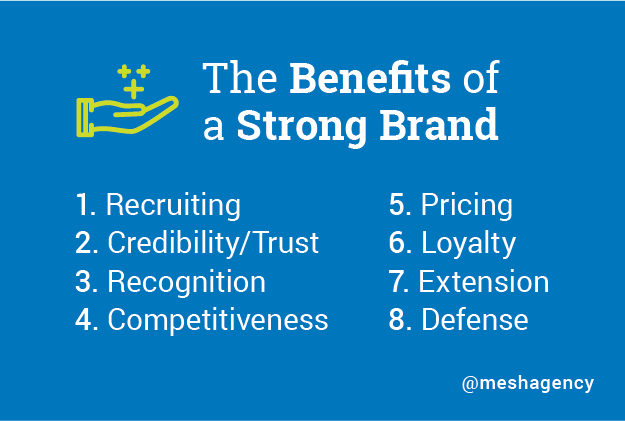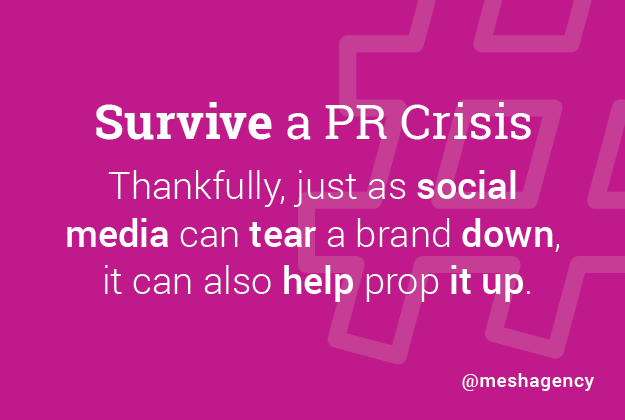In the last few years I’ve seen companies make all manner of branding and marketing mistakes—and I wanted to provide companies that were thinking about their branding—whether it is a strong brand or weak—with some guidance on what NOT to do with their brand. With that in mind, we’re going to look at the benefits of a strong brand to your company.
While I received the typical “great post” and “thanks for the wonderful insight” comments—there was one comment I received from a new client that was particularly impactful. This client, who’d been in his industry for 20-something years, is an engineer, and his perception on brands is telling:
“At the end of the day, we’re all providing the same thing. I don’t really see what’s different about any of us, and so I don’t really get why we have to spend all this money on a ‘brand’ and marketing. We get the work because we’re close to the client, and they like us.”
I thought about this perspective for a bit. He’s not wrong—from a “certain point of view” (spoiler—just saw Star Wars: The Last Jedi—loved it). In his world, until MESH showed up, his company probably did seem just like other companies that do what they do. And that’s because, while they had a cool logo, they didn’t have a brand.
See, your brand isn’t a logo. Or a tagline. It’s what people think and say about you—when you’re not there. Off- AND Online. And making sure that you have a strong brand is key—because there are quite a few benefits your business can reap due to a strong brand.
Benefits of a Strong Brand
1. Recruiting – According to entrepreneur.com, “The information that job candidates hear or read about your company will leave them with a basic impression of what it’s like to work there. If social-media postings about working for your company are overwhelmingly negative or employee reviews repeatedly point out an important weakness, some candidates may choose not to interview with your firm.” On the other hand, a strong brand can help you attract and recruit talent.
2. Credibility/Trust – A strong brand will help you be more credible. According to Forbes, “With so many companies competing for customer interest, the ability to truly connect with your users in a way that forms a sense of trust is critical.” Would YOU buy from a company that you don’t trust? A strong brand will help your buyer trust what they’re buying—especially important in service and B2B sales.
3. Recognition – It’s the holy grail of B2B marketing and sales and one of the most obvious benefits of a strong brand: that moment when someone mentions your company’s name and your customer says “yeah, I know them”. THAT is recognition. It’s easy to come by in B2C, and much harder (some would argue nearly impossible) in the service space. But a strong brand is by definition recognizable—making it easier for your buyer to establish trust.
4. Competitiveness – If your brand is strong—perhaps you’re recognized—and you can quickly establish trust—that makes you that much more competitive in the space. Think about the last time you made a purchase. Did you select the solution that you recognized and trusted? Or did you go with a no name, no reputation solution? There’s a good chance you selected what you know—and inherently that company’s strong brand made it more competitive.
5. Pricing – According to Ira Kalb of Marshall School of Business, USC, “The more uniqueness that marketers can build into the key component of positioning of each of their products, the more they can control the price.” Ultimately the more you can differentiate your product or service, and the better you can communicate the value of that difference, the better chance you have of commanding price. This is an often overlooked benefit of a strong brand: commanding price, particularly in an economic downturn.
6. Loyalty – There is a lot of discussion about how brand loyalty is dead. Even Millennials have been accused of killing it. But in our experience (and here are some good examples), brand loyalty is alive and kicking—and powerful—even if you have to pay a little for it.
7. Extension – When done well, a strong brand can help you extend your product or service into new areas. If you’re already successfully selling to customers with an established solution, you already have an in to sell related and complimentary services—as long as you do it well.
Bonus Tip: Defense – If you have a strong brand, you can leverage this to help you work through—and survive—a public crisis like disgruntled employees, a product recall, negative customer feedback, or even a smear campaign by a competitor.
Much has been written about most of the above benefits of a strong brand, so I’m going to focus on this last aspect that doesn’t get a lot of attention these days: surviving a PR Crisis.
Leveraging a Strong Brand to Survive a PR Crisis
When your company’s reputation comes under the scanner, you may think it’s all doom and gloom from thereon. The growing ubiquity of social media has the potential to turn a PR blunder into a firestorm. In fact, large companies today also anticipate being tweeted at by the President of the free world. Thankfully, just as social media can tear a brand down, it can also help prop it up. This can be a huge benefit of a strong brand.
But first, you should respond to crises sensitively and appropriately, a feat that some companies have achieved long before Facebook and Twitter were household names.
1. Take responsibility for the situation and act quickly
The worst reaction—and way to use social media for a PR crisis—is to cover it up and defend your company. The best strategy is to own up to the issue and issue a statement immediately on your social media page(s). Address people’s concerns and indicate the actions you have implemented. No matter how severe the crisis and regardless of where the blame lies – did your product team bungle, can the issue be traced to your factory or is it the supplier’s fault – tackle it head-on.
Back in 1982, Johnson & Johnson faced a huge PR crisis when seven people in Chicago died after consuming Tylenol. FBI investigations revealed that someone had filled eight Tylenol bottles in stores with cyanide pills, though the individual’s identity remains a mystery to this day. Tylenol’s response to this potentially brand-killing scandal was to (a) issue warnings to distributors (b) recall the product nationwide (c) set up a hotline to answer questions around the problem (d) inspect its factories to determine the origin of the problem and (e) cooperate fully with investigators.
Despite finding itself in the eye of the storm, Johnson & Johnson survived and moved on quickly in what is still recognized as an exemplary PR response to a crisis of this kind.
2. Don’t take criticisms lightly
Trolls are an unsavory element of social media, but they have their value too! Creative brands either ignore trolls or defeat them with witty answers, frequently to the applause of their fans and followers. But brands that have mastered the PR game are careful not to dismiss genuine criticisms from their social community. Others learn it the hard way.
Following the death of music superstar Prince, Minneapolis-based Cheerios tweeted a ‘Rest in Peace’ image with the ‘i’ in ‘in’ dotted with a Cheerio. Fans responded angrily to how the company’s message was more marketing-oriented than heartfelt. Cheerios issued a tone-deaf explanation, saying that it had only intended to mourn the loss of the Minneapolis-born legend. Not surprisingly, Twitter users drove the point home about the ‘commercialization’ of a loss by screen-capping Cheerios tweet with their own sarcastic versions.
3. Learn from the crisis and establish corrective action
Online criticisms are opportunities for learning. A PR crisis can help you understand your audience at a deeper level and fill the missing pieces of the customer analytics puzzle. You may discover that some of your customers prefer to be always politically correct, which means you cannot afford to post an Instagram picture or retweet something that can be mistaken as racist, sexist or insensitive. While smaller mistakes will be quickly forgotten, major ones that directly impact sales and competitiveness require more attention.
Going back to Johnson & Johnson’s case, the company’s post-crisis management did not stop at communicating what happened and what measures were taken, but also the implementation of new measures to prevent a recurrence. Following the incident, the multinational brand distributed their pills bottles with tamper-proof packaging and also added a $2.50 coupon to each as a goodwill gesture.
In contrast, Samsung last November handled the Galaxy Note 7’s overheating batteries issue in the worst possible way. For one, the notification about the safety issue was not prominently highlighted on their website and easily missable. The company also issued late alerts on social media channels, and the final straw was issuing a statement in Hong Kong that customers’ phones were not affected by faulty manufacturing only to withdraw it once the truth came to light. Following the fiasco, Samsung’s mobile revenue fell by nearly 96%.
A winning response would have seen the multinational brand acknowledge the manufacturing fault, communicate it quickly instead of issuing wrong information, and resolve the battery problem on a priority-basis.
Invest in the RACE public relations model: research, action, communication and evaluation. A systematic approach to PR crises can prevent missteps and help you focus on areas that need the most attention.
4. Increase positive sentiment
Brands that know a thing or two about surviving PR crises will agree that making amends is more than implementing corrective action, though this is also critical. If a tweet or advertisement earns you bad press, your PR team should devote effort towards changing the negative perception about your brand by continuing to talk after the crisis. You want to get out there and tell people that you are capable of good, appreciative things.
In 2012, Carnival Cruise Line, the world’s largest cruise line, suffered a major crisis after one of its luxury liners toppled, sank and resulted in multiple deaths. In only 18 months, the brand managed to turn the situation around and increase cruise purchases by leveraging earned media.
Carnival Cruise Line created a pipeline of good news to soften the blow of the bad news. They enlisted their new CEO Arnold Donald to communicate positive stories, highlighting his record for safe operations and innovation, underscoring safety as the highest priority, communicating the value and features of their cruise vacations, and showcasing technology improvements to new ships as well as the brand’s sustainability and environmental initiatives.
The effort earned them YouGov’s ‘most improved US brand in consumer perception’ title. Carnival Cruise Line’s transparency and proactive approach to changing negative sentiment helped them recover in half the time it usually takes brands to emerge from major crises.
5. Get support from third-party advocates
Thanks to social media, recruiting brand advocates isn’t as laborious a process anymore. If you have a social media advocacy program in place, you can rely on your staunchest fans and followers to support you during a PR crisis.
While your customers are your most trusted advocates, academics and industry analysts who don’t have a financial or vested interest in your company, they can also do their bit to quell negative sentiment around your brand. Dell, IBM, Cisco, Sprint and Deloitte have hundreds of thought leaders and advocates who the companies mobilize to address critical situations on social platforms.
Though your spokesperson will always be the point-person for all official post-crisis communication, advocates’ reassurance on social media can help you tide over a difficult situation more quickly and easily.
Components of a Crisis Management System
- Create a crisis communications team that will decide the best course of action and communicate a consistent message to internal and external stakeholders.
- Brainstorm on potential PR emergencies, and determine the most appropriate response to each. Imagine scenarios, assign roles, and create brief holding statements for various scenarios.
- Draft a list of all key internal and external stakeholders who should receive news of any major PR crisis on an immediate basis.
- Identify who will serve as the spokesperson(s) and who can be authorized to talk to the press.
- Revisit the plans to assess if you need to add more actions or modify your tone. Use competitors’ response strategies to improve your crisis management system.
Have you had to survive a PR crisis? Were you able to leverage your own strong brand to survive it? If so, how? Do you feel that your brand is strong enough to sustain a substantial PR crisis? If not, we’d love to talk with you about your concerns and needs today!






